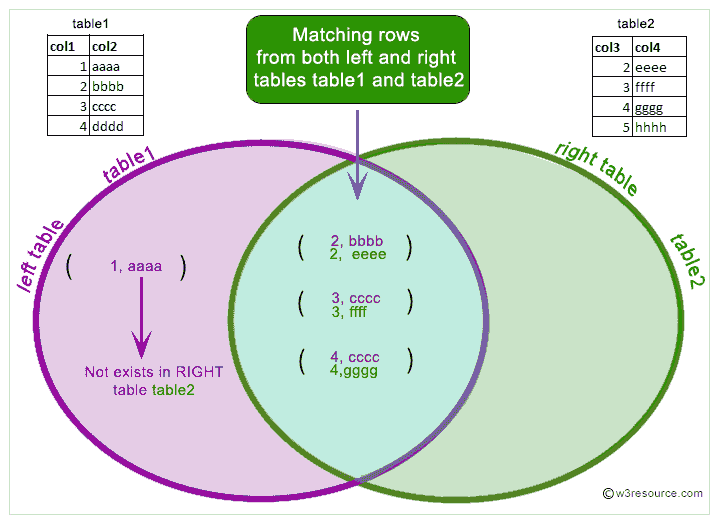When to use a join in SQL? What does left join mean? The result is NULL from the right side, if there is no match. The condition that follows the ON keyword is called the join condition B. Let’s take a look at the countries and locations tables. LEFT JOIN and LEFT OUTER JOIN are the same.
Each location belongs to one and only one country while each country can have zero or more. It returns all rows from the left table and the matching rows from the right table. If no matching rows found in the right table, NULL are used. An SQL join clause - corresponding to a join operation in relational algebra - combines columns from one or more tables in a relational database.
It creates a set that can be saved as a table or used as it is. Venn diagrams illustrate the difference in output rows for special cases of inner vs outer join. The easiest and most intuitive way to explain the difference between these four types is by using a Venn diagram, which shows all possible logical relations between data sets. APPLIES TO: SQL Server Azure SQL Database Azure Synapse Analytics ( SQL DW) Parallel Data Warehouse Returns the left part of a character string with the specified number of characters.
An SQL JOIN clause is used to combine rows from two or more tables, based on a common field between them. The LEFT OUTER JOIN selects all rows in the right table that match the relational comparison criteria, and also selects all rows from the left table, even if no match exists in the right table. SQL OUTER JOIN – left outer join. Suppose, we want to join two tables: A and B. It means the result of the SQL left join always contains the rows in the left table.
SQL left outer join returns all rows in the left table (A) and all the matching rows found in the right table (B). Left Outer Join in SQL returns all records from the left table (table1) and the matched records from the right table (table2). Example of SQL LEFT OUTER JOIN. Let’s create the two tables given below to understand the example of left outer join in SQL server. Below are the two tables contain the column with one column matching rows.

The first table is Purchaser table and second is the Seller table. Having the “dept_manager_dup” table, M, or the “departments_dup” table, on the left , can change completely. In this article i would like to give information about How to join tables in SQL with examples. If you dont know the joins its really very difficult how to join tables in SQL.
So the main question in users mind will be How to Join tables in SQL and where it is used. A LEFT OUTER JOIN is one of the JOIN operations that allow you to specify a join clause. It preserves the unmatched rows from the first ( left ) table, joining them with a NULL row in the shape of the second (right) table. There are so many situations.
Sharpen your SQL skills. PROC SQL joins do not require that common variable have the same name in the data sets you are joining, while you need to have common variable name listed in BY option when using MERGE statement. In SQL , a join is used to compare and combine — literally join — and return specific rows of data from two or more tables in a database. An inner join finds and returns matching data from tables, while an outer join finds and returns matching data and some dissimilar data from tables.
The SQL Left Join is a SQL Join Type used to return all the rows or records present in the Left table and matching rows from the right table. Let us see the visual representation of the SQL Server Left Outer join for better understanding. From the above image, you can understand easily that the. In case of no match with right side table it will return NULL value.
Left Join ” and “ Left Outer Join ” are used interchangeably because records which are returned will be the same with either of these. Learn how to use left and right joins using the plus sign in an Oracle database. JOIN 4: Outer join between DT and SalesOrderHeader resulting in a derived table, DT 4. JOIN 5: Outer join between DT and SalesTerritory resulting in a derived table, DT 5. DT is the final result of the query.
Nincsenek megjegyzések:
Megjegyzés küldése
Megjegyzés: Megjegyzéseket csak a blog tagjai írhatnak a blogba.